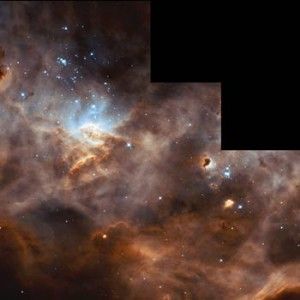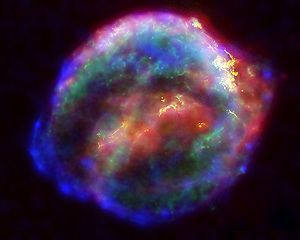Cosmos: Star Cycles

With some 100 billion galaxies, many containing some 200 billion stars, the universe would seem to be dominated by stars. But the entire stellar inventory represents something like one percent of the mass of the universe.
Despite their diminutive contribution to the mass of the universe, stars play a vital role in the evolution of the cosmos. They are the engines that produce all the chemical elements that comprise atom-based matter except for hydrogen and helium, the first elements to form after the Big Bang. Life would never have emerged without those elements, so stars are the fundamental source of life. Stars are also the heart of planetary systems, without which complex forms of life would not occur.
Star formation. The earliest stars began to form when the universe was between 100-300 million years old. Areas of scattered density in the otherwise smooth void attracted cold drifting hydrogen. Incremental increases in gravity attracted ever more gas. Eventually, immense gravitational pressure forced the gas clouds to spin and compress. Where sufficient mass accumulated to trigger nuclear fusion, stars burst into existence.
Some of the earliest stars may have been isolated giants, but many collected into globular clusters, stellar groupings that did not evolve into galaxies. Some of these clusters are estimated to be as old as 13 billion years. The formation of younger generations of stars can be observed today in molecular clouds called star nurseries such as the iconic Eagle Nebula. Since individual stars within clusters represent different stages of development, the clusters are a major resource for the study of star formation.
Star life-death cycle. Many of the earliest stars were behemoths, millions of times more massive than our Sun, and consisted only of hydrogen and helium. Scientists are still trying to understand the formation of the early giant stars and how such extreme stellar masses might have affected the formation of galaxies. But it is quite certain that the first generation of oversized stars would have exhausted their fuel within 100 million years or so. For stars, this is a brief stellar lifetime. Average stars like our Sun last for billions of years.

The first-generation stars died in spectacular explosions called supernovas. The extraordinary heat and pressure of supernovas produce more complex chemical elements, and those elements are subsequently absorbed by a future generation of stars. There are still supernovas, and they are still massive --at least 25 times the mass of our Sun-- but they may not be as huge as those from the earliest generation of stars in the universe. After a star goes supernova it may form a gravitational aberration such as a black hole. If the star's end falls just short of supernova, it may collapse into another unusual type of hyper-gravitational entity, such as a neutron star or magnetar (a rare, super-massive neutron star). These structures are among the most intriguing objects in the cosmos, and understanding them will help unravel many mysteries about the nature of the universe.
Supernovas and black holes may offer insight into the relationship between large-scale phenomena, the domain of general relativity, and sub-atomic phenomena, the domain of quantum mechanics. Supernovas are also important in astronomical calculations; the light from these explosions is so distinct and intense it exceeds that of entire galaxies and can be seen at great distances across the universe. Although the initial brightness fades in a short time, the residual glow can be observed for years, even for centuries.
Stars of average mass, such as our Sun, have long lives. During the course of their lives, some may get larger or hotter. Our Sun, for example, was about 30 percent dimmer some 4 billion years ago. When average stars burn through their hydrogen fuel they begin a long death ritual. First they balloon out, becoming red giants. This will be the fate of the Sun, and in its red giant stage it will engulf and vaporize much of the solar system. Over time, the ballooning red giant collapses, the mass diminishes and it becomes a stellar cinder. Hubble Captures Stars Going Out In Style
Stellar nucleosynthesis. Nuclear fusion, the engine of the star, converts hydrogen into helium. But in a process called stellar nucleosynthesis the star also produces the heavier elements up to iron. The first generation of stars produced carbon, nitrogen and oxygen. Together with hydrogen, these elements are the most common in the universe, the they are essential for the formation of life.
The heavier elements are created especially in the star's death throes. The star heaves and collapses several times; with each collapse the next heaviest element is created. The heaviest elements of all, such as gold and uranium, are produced only in the most extreme heat and pressure known in the universe: the type-2 supernova explosions or the collisions of neutron stars. The explosive finales of giant stars eject enormous clouds of molecular detritus well out into the universe. Over millions of years a new generation of stars forms in the dust clouds, and the gravitational force of those stars will cause the formation of planets and other objects. These objects, all comprised of star dust, contain the elements generated by the first generation of stars. For this reason, second-generation stars such as our Sun are more chemically complex than the original stars in the universe. And planets, asteroids and comets also contain elements that did not exist in the early universe.
Some star species. Supernovas are the celebrities of the universe, but there are many other types of stars. The main characteristic is size. Most luminous stars are average-sized, like our Sun. Then there is a very diverse population of dwarfs, the small, dim stars that make up most of the stellar population.

Two of the most common types of stars are brown dwarfs and red dwarfs. Brown dwarfs are somewhat ambiguous structures, considered too large to qualify as gas planets, but lacking the mass necessary to produce fusion; they are often called "failed stars." There are a great number of these invisible castoffs in the universe.
Red dwarfs (also known as M-Dwarfs) do ignite, but at too low a level to be luminous. These quiet little stars are very common and would seem to be uninteresting; but in recent years they have been attracting special interest. One reason is that they burn for billions of years, so the oldest ones are a good source of information about the history of the universe. Another reason for intense interest is that the mass of many red dwarfs is sufficient for the formation of solar systems, so they are prospective targets in the search for exoplanets.
While most of the dwarf types, including the brown and red types, represent a kind of arrested development, white dwarfs are simply the end stage of former radiant stars like our Sun. After such stars complete the "red giant" state they morph into a stellar cinder that slowly cools over millions of years.
